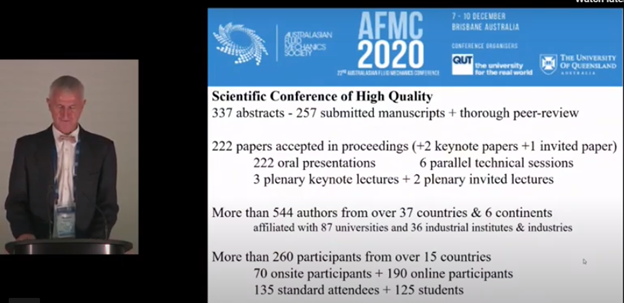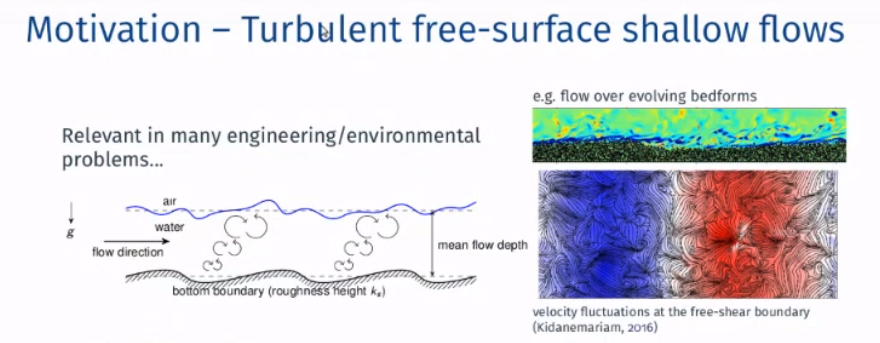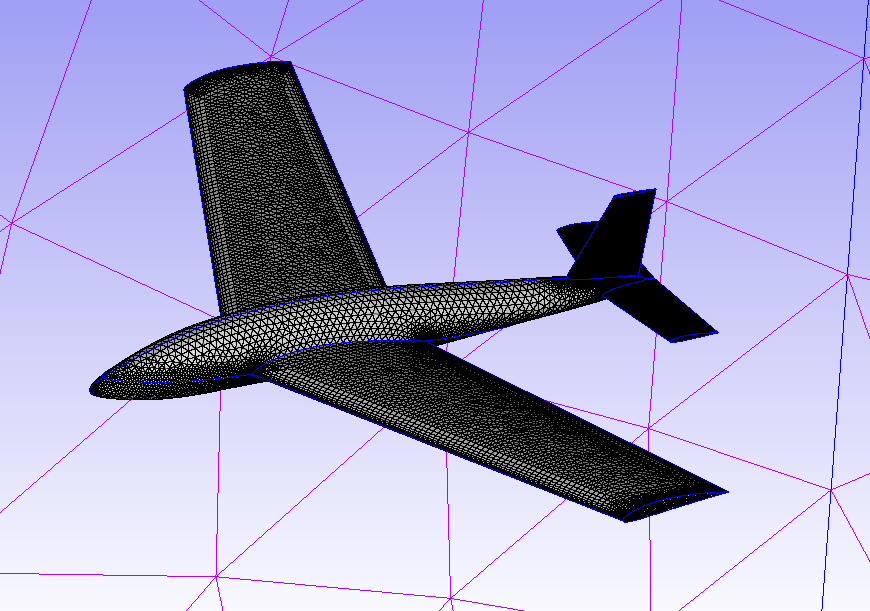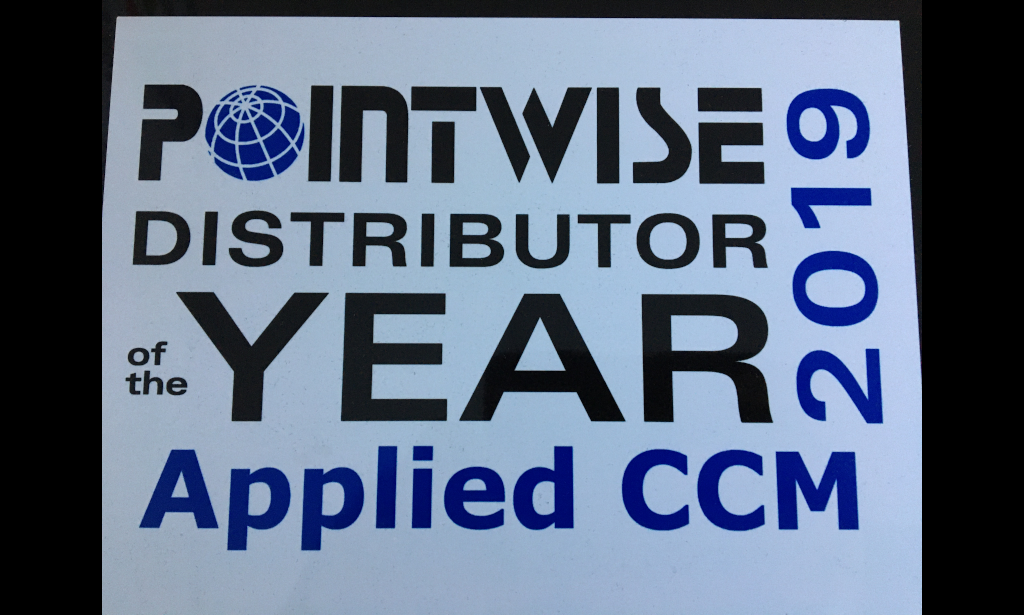AFMC2020 – 22nd Australasian Fluid Mechanics Conference
AFMC (Australasian Fluid Mechanics Conference) is held biannually in Australia, and the 22nd AFMC2020 was the latest, held in December 2020. AFMC2020 was organised by Australasian Fluid Mechanic Society (AFMS), and this year predominantly by University of Queensland and Queensland University of Technology. This was the first time the AFMC2020 was held both in-person and virtually, due to COVID.
With COVID limiting travel plans, I attended AFMC2020 virtually, and the experience wasn’t bad. The virtual platform had all the essential features one expects of virtual events. Virtual meeting room, messaging, ability to join currently running events, and ability to raise a hand to go on ‘main stage’ for video question were good. The best way of interacting was being able to type questions into Q&A. The audio and video quality were good when it was working, but there were enough ‘technical difficulties’ to disrupt the flow of talks. The AFMC2020 organisers and A&V staff patiently dealt with these and in some cases used pre-recorded videos or shuffled the order to allow the talks to go ahead. No doubt there was room for improvement, and the platform creators ‘OnAir’ and organisers will no doubt learn many lessons and overall, it was a good first effort.
If virtual conferences were to continue (and why wouldn’t they?) I think there is a big opportunity for changing the way we digest live presentations. It would be better if the presenter slide pack were available in the virtual interface to be viewed by the virtual audience. The example that comes to mind is during conclusions or question time when the results are not on the screen, it would be good to flick back to a slide and comprehend what the conclusions mean in terms of the results presented.
AFMC2020 Details
AFMC2020 had 260 attendees from 15 countries, 70 onsite, 190 virtual/online. The majority were from Academia, more than a dozen from Government (mainly Defence), and a small number from industry. The conference was run with 6 concurrent sessions and there were 5 networking sessions.
There were 222 papers + 2 keynote lectures and 1 invited paper. The 554 authors were made up from 37 countries, 87 universities and 36 industry institutes and industries (Figure 1). Proceedings are now published and accessible in open access here.

AFMC2020 is a good place to hear and see what fluid dynamics research and application is being conducted both locally and internationally. There were 28 topics. Some of these included biomedical, atmospheric, jets/wakes, computational methods, experimental methods, oceans, combustion, industrial, renewables, hydrodynamics and aeroacoustics,
Favourite talks at AFMC2020
My 3 favourite talks from AFMC2020 were as follows:
1 – Title: On the turbulence-generated free-surface waves in open-channel flows, Authors: Dr Aman Kidanemariam, Research Fellow, The University Of Melbourne. (Figure 2)
The authors performed high-fidelity numerical simulations of turbulent open-channel flows, accounting for nonlinear wave dynamics at the free-surface. The turbulence-induced dispersion was well represented by a diagnostic characteristic frequency. This frequency was defined taking into account the nonlinear free-surface kinematic boundary condition. It was shown that dispersion exhibits a collapse above a certain critical wavenumber when scaled by free-surface turbulent length and velocity scale.

2 – Title: Hydrodynamic simulation of submarine far-field flow. Authors: Ciaran Chisholm, Bagus Nugroho, Kevin Kevin and Rey Chin from The University of Melbourne, Imperial College London and The University of Adelaide (Figure 3).
The paper focussed on the DARPA suboff submarine and was meshed with snappyHexmesh (with 20M elements). Numerical results were developed with OpenFOAM solver. The turbulence model was RANS k-omega SST. The authors investigated wake flow 36D downstream of the stern tail. Despite the long downstream length of the domain, the numerical results showed a lack of similarity for total kinetic energy downstream in the wake.

3 – Title: Two‐dimensional Numerical Simulation of Inkjet Print‐zone Flows, Authors: Andre Aquino, Sam Mallinson, Geordie D. McBain, Glenn Horrocks, Charita de Silva and Tracie from UNSW and Memjet Pty Ltd (Figure 4).
This paper focused on the modelling of ink from inkjet printers, and the airflow/ink injection dynamics in the vicinity of the printing zone. A two-dimensional computational model was developed and refined to accurately capture the flow with OpenFOAM-7 solver pimpleFoam.

AFMC2020 Awards and AFMS Fellows:
There was 7 new fellows elected into AFMS at AFMC2020.
Jen Zen Ho from the University of Melbourne won the student prize (Sam Luxton Award), awarded for content/presentation.
Thomas McQueen from Monash University won the Tony Perry prize for best non student paper.
Next AFMC
Next years 23rd AFMC will be held in Sydney at the University of Sydney from 5-9 December 2022.
Applied CCM Paper
This AFMC I co-authored a paper on car park ventilation, and comparing Applied CCM’s Opensource solver Caelus with FDS, a fire industry solver for smoke and fire modelling. It was titled “A Comparison of FDS, ANSYS-CFX and Caelus for Car Park CO Ventilation“. For some more info on this topic see here on the blog Another Fine Mesh, by Pointwise Inc.
Our last conference review was from CFD/DEM Conference December 2018, in case you missed see here.



